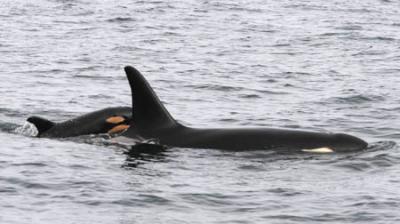
For Orca Babies

This Earth Month, we have four Southern Resident orca babies to celebrate -- cautiously. Technically, the calves are not included in the census until they have survived one year. With roughly 50% mortality in the first year, not all four newborns may survive. At either 78 or 82 counting the babies, the number of Southern Residents is still distressingly low, and their population remains critically endangered.
In orca recovery, most stakeholders broadly agree that the following threats imperil the survival of J, K, and L Pods: depleted Chinook salmon runs; persistent bioaccumulative toxins; careless deployment of military sonar; climate change; and the risk of oil spills and diseases.
Removing dams and other improvements to the orcas’ critical habitat might yield benefits in the long term, but the Southern Residents are suffering today. Protecting orcas from disruptive vessel effects is one conservation issue we can tackle now.
Denial and complacency prevent some from acknowledging that vessel effects, specifically from boats pursuing these endangered orcas, also jeopardize recovery of the Southern Residents. What you may not realize is that much of the opposition to mitigating vessel effects comes from people with close ties to the whale watch industry.
The engine noise and presence of just a few boats can disturb orcas’ foraging, socializing, and resting. Commercial tour boats inevitably beckon curious recreational boaters. Consider the cumulative impact: when dozens of boats pile up on the Southern Residents, it matters little if boaters are adhering to anemic voluntary guidelines or unenforced laws.
Research shows that when the Chinook salmon supply is low, the noise and presence of boats intensify harm to the Southern Residents. The whales forage less when surrounded by vessels and expend precious energy dodging boats. Starving whales metabolize the deadly toxins stored in their blubber.
Another study shows a 15-20% increase in the duration of orca calls to compensate for boat noise. In other words, killer whales must “talk” louder to each other to be heard above the increasing underwater din.
For Earth Day homework and additional perspective, check out the vessel effects studies in NOAA’s report, “Southern Resident Killer Whales: 10 Years of Research and Conservation” at www.nwfsc.noaa.gov. Read “Whale-Watching Found to Stress Out Whales” at http://www.scientificamerican.com/article/whale-watching-found-to-stress-out-whales/. Review the proposal for a Southern Resident Whale Protection Zone the at www.orcarelief.org
What humans find convenient is often contrary to optimal conservation practices. The desire of “Digital Humans” for instant notification about locations of endangered whales is at odds with the precautionary principle. The electronic trail of sightings attracts boats. Shore-based whale watching is supposed to be a sustainable alternative, but chasing orcas all over Puget Sound by car and ferry erodes that sustainability. On Earth Day, think of that carbon footprint.
Southern Residents endure year-round whale watching stress throughout the Salish Sea. Commercial and recreational boats are already converging on the J Pod newborns. We can help the orca babies thrive by reducing viewing pressure on them, seriously considering a whale protection zone off the west side of San Juan Island, and by living more consciously, selflessly, and sustainably in Southern Resident habitat.
Please support the work of the Vashon Hydrophone Project (VHP): REPORT LOCAL WHALE SIGHTINGS ASAP TO 206-463-9041, as well as seal pups and sick, injured, or dead marine mammals on Island beaches. Prompt reports to the VHP expedite vital data collection efforts and sustain an accurate record of whale sightings for Vashon-Maury initiated three decades ago by Mark Sears. Send photos to Orca Annie at Vashonorcas@aol.com and check for updates at Vashonorcas.org.
- Login to post comments
